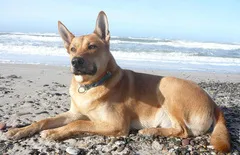
Bichon Frise
Bichon Frise is usually completely white, with thick coats that stand away from the body in loose curls. He is playful, curious and intelligent.
Overall Status
| Height | 9.5 to 11.5 inches at the shoulder |
| Temperament | Playful, Curious, Peppy |
| Weight | 10 to 18 pounds |
| Life Expectancy | 15 + years |
| Coat Color | White |
| Barking Level | Medium |
Quick Factors
| Playfulness | |
| Dog Friendly | |
| Exercise Need | |
| Grooming Needs | |
| Strangers Friendly | |
| Family Affectionate |
Daily Care
Grooming Tips
Brushing is required at least twice per week and their white coats get dirty quickly, so baths are very common. Brushing should always be done before a bath, because the hair naturally tangles in the water. Tangles and mats that are present before a bath will be nearly impossible to remove and have to be cut out.The coat will need to be trimmed every six weeks to maintain a good length. Most owners keep a standing appointment every four to six weeks with a groomer to keep up with baths, trims, nail clipping and ear cleaning as grooming a Bichon is not for the faint of heart or for those pressed for time.Bichons are prone to eye tearing which can stain the face. Veterinarians can recommend eye wipes or solutions that can reduce the tearing, relieve discomfort for the dog and help keep their white faces clean.
Exercise Tips
The Bichon is classified as “somewhat active,” but that’s an average. Long stretches of calm are interspersed with brief bursts of high activity, often just running through the house or around the yard.Daily play sessions, in addition to walks, are required. Another dog can be a fine exercise companion, but the Bichon will still need quality playtime with his owner.A fenced-in backyard is a good idea; Bichons are surprisingly fast, and if one makes a dash for freedom, he may be difficult to catch or to call back to you. Many Bichons enjoy participating in obedience, agility, and rally competitions.
Feeding Tips
Whole foods including good cuts of meat are great for the Bichon Frise. It might be easy to spoil them, but be sure that they receive a steady diet of whole, natural foods that they’ll be able to enjoy. Don’t overfeed them.They should do well on high-quality dog food, whether commercially manufactured or home-prepared with your veterinarian’s supervision and approval.Any diet should be appropriate to the dog’s age (puppy, adult, or senior). Some dogs are prone to getting overweight, so watch your dog’s calorie consumption and weight level. Treats can be an important aid in training, but giving too many can cause obesity.Learn about which human foods are safe for dogs, and which are not. Check with your vet if you have any concerns about your dog’s weight or diet. Clean, fresh water should be available at all times.
Health Tips
Bichons are generally healthy dogs, and responsible breeders will screen breeding stock for health conditions such as allergies, bladder infections, luxating patella, and cataracts and other eye diseases.Bichons may experience early tooth loss or complications from gum infection if dental care and regular tooth brushing are not a priority. To avoid ear infections, regular ear cleaning is recommended.
Trainability
Generally, the Bichon Frise is a worry-free dog in terms of training, perhaps a reason they were so popular in the trading world of Europe where it would be easy to acquire a dog and acclimate it to ventures such as sailing and bartering.It might require a little bit of patience to deal with the Bichon Frise if you’re a first-time dog owner, but proper training will go a long way in this breed. Being sure to socialize this dog with other dogs early on is a good idea.
History
The history of the Bichon Frise began centuries ago in the Mediterranean, where they became prized for their friendly dispositions.They are believed to be descended from the Water Spaniel and as a breed spread rapidly throughout Europe, finding much early favor in Spain. In the 1300s, this lovable little breed became favorites with Italian nobility.In the 1500s, they were favored in France, and their popularity in Spain continued throughout these eras. In the 15th and 16th centuries, the breed flourished on the Canary Islands off the northwestern coast of Africa.In the late 1800s, the Bichon Frise lost its aristocratic popularity in Europe and became more of a common dog, running loose in the streets of Europe and performing with organ grinders and in circuses and fairs.After World War I, a few fanciers in France and Belgium began re-establishing the breed through careful and controlled breeding programs.The official breed standard was adopted in France in 1933, and the Bichon Frise was admitted to the studbook of the French Kennel Club in 1934. The Bichon Frise was introduced to the United States in 1956, and they debuted in the Non-Sporting Group at American Kennel Club dog shows in 1973.






